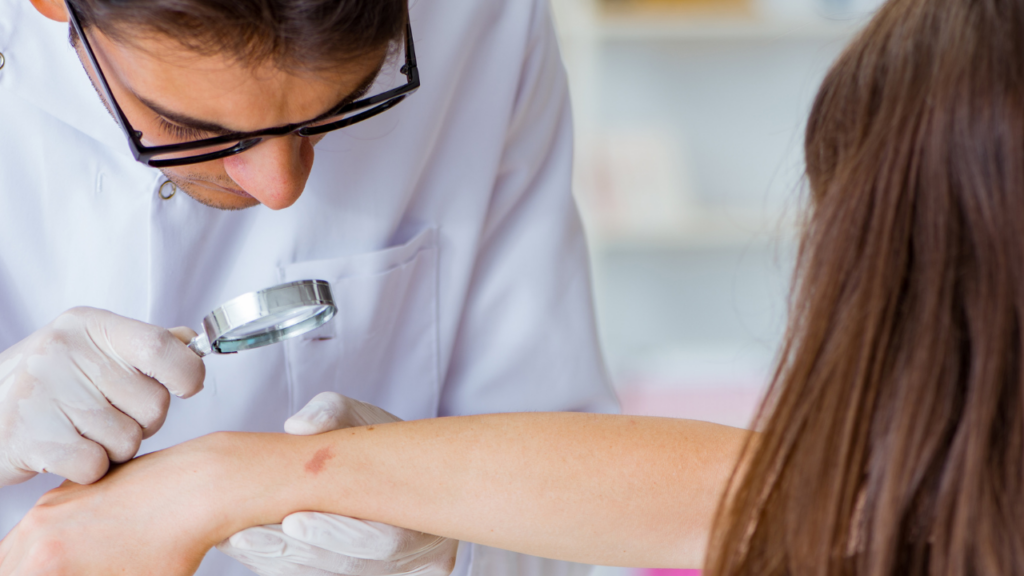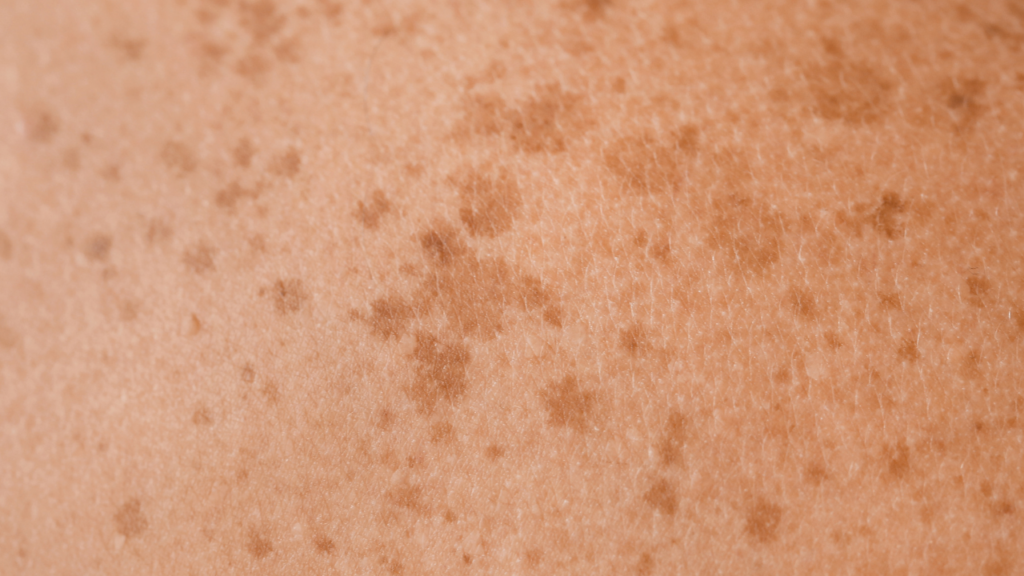|
Getting your Trinity Audio player ready...
|
Skin cancer is one of the most common cancers worldwide, affecting millions of people every year. Despite its prevalence, early detection and knowledge can significantly improve the prognosis and treatment outcomes.
This comprehensive guide aims to demystify skin cancer, shedding light on its different forms and offering vital information on detection, prevention, and care. Understanding the nuances of skin cancer is crucial, given that it can manifest in numerous ways across various skin types, often influenced by genetic and environmental factors.
Understanding Skin Cancer and Its Types
Basal Cell Carcinoma
Basal cell carcinoma (BCC) is the most common type of skin cancer, known for its slow growth and rare metastasis. It typically develops in areas frequently exposed to the sun, such as the face, neck, and ears. BCC may manifest as a pearly or waxy bump, a flat, flesh-colored, or brown scar-like lesion, or morph into sores that heal and then reappear. Regular examination of the skin for any new growths or changes, particularly in sun-exposed areas, is essential for early detection. While BCCs are often effectively treated with surgical excision or Mohs surgery, recognition and timely intervention by a dermatologist are key to minimizing extensive tissue damage.
Squamous Cell Carcinoma
Squamous cell carcinoma (SCC) is the second most prevalent type of skin cancer, often resulting from prolonged exposure to UV radiation. SCC typically appears as a hard, scaly patch, a red nodule, or a lesion with an irregular border. It can occur on all parts of the body, including the mucous membranes and genitals, but is most common in areas exposed to the sun, like the scalp, backs of the hands, and ears. Unlike BCC, squamous cell carcinomas carry a higher risk for metastasis if not detected and treated promptly. Suspicious lesions should prompt a consult with medical professionals, as early detection greatly enhances treatment efficacy.
Melanoma
Melanoma is regarded as the most severe form of skin cancer due to its tendency to spread rapidly to other parts of the body. This cancer starts in melanocytes, the cells that produce melanin, which gives skin its color. Melanoma may appear without warning but often develops within an existing mole. It is characterized by a change in size, shape, or color of a mole, or by the appearance of a new pigmented growth on the skin.
Regular self-exams and professional skin exams play a crucial role in noticing any suspicious changes. Key factors such as a mole’s asymmetry, irregular border, variegated color, diameter greater than the size of a pencil eraser, and evolution over time are signals that warrant immediate attention from a dermatologist. While melanoma can be more difficult to treat than other skin cancers, early detection significantly increases the chances of a successful outcome.

The ABCDEs of Skin Cancer Guide
Asymmetry
One of the first characteristics to assess in a mole or skin lesion is its symmetry. If you draw a line through the middle of a mole, the two halves should mirror each other. Research shows that asymmetry, where one half differs from the other, is a conspicuous feature that sets off alarms. Melanomas are frequently asymmetrical, unlike many benign moles which are usually round and symmetrical.
Border
The borders of noncancerous moles tend to be clearly defined and smooth. In contrast, the edges of an early melanoma might be uneven, scalloped, or notched. Keep a lookout for the borders of spots on the skin to ensure they remain well-defined over time. Changes in this characteristic demand professional evaluation.
Colour
An even, single color is typical of most benign moles that are harmless. However, the presence of a variety of colors or an uneven distribution of color can be a warning sign. Melanomas might include different shades of brown, tan, or black, and can even become red, white, or blue. Monitoring moles for consistent coloration is another key step in early identification.
Diameter
While melanomas can sometimes be smaller when first spotted, they are typically larger in diameter than a pencil eraser (approximately 6mm). It is important to keep an eye on moles or growths that have a larger diameter, as this may be indicative of melanoma.
Evolving
Any change in a mole or skin growth is a significant concern. This includes alterations in size, shape, color, elevation, or any new symptoms such as bleeding, itching, or crusting. Evolution or change is a critical warning sign that a mole or skin growth may be malignant.
Skin Types and Skin Cancer Risk
Determining Your Skin Type
Skin types are categorized by how the skin reacts to sun exposure and can range from type I, which burns very easily and rarely tans, to type VI, which naturally has dark brown or black skin and never burns. The Fitzpatrick skin type classification system is the standard for determining the response of different skin types to UV light and the susceptibility to skin damage. Identifying your skin type is crucial for recognizing your risk and adopting appropriate sun protection strategies tailored to your skin.
The Connection Between Skin Type and Skin Cancer
Individuals with lighter skin types are generally at a higher risk of developing the most common forms of skin cancer, such as basal cell carcinoma and squamous cell carcinoma, because their skin has less melanin. Melanin is the pigment responsible for skin color and provides a degree of protection against UV radiation-induced damage. Conversely, while those with type V and VI skin are less prone to these skin cancers, they remain at risk for certain types of melanoma, especially in less pigmented areas of the skin. It is a critical reminder that regardless of skin type, monitoring for any unusual skin changes and regular skin cancer screenings are imperative for early detection.

Spotting Skin Cancer Early – Skin Cancer Guide
Check Your Skin for Warning Signs
A regular self-exam should become a part of your health routine. This entails a thorough examination of your entire skin surface, including areas not typically exposed to the sun. Using a mirror or the assistance of a close friend or family member, scan all areas including the back, scalp, soles of the feet, in between the toes, and other hard-to-see places. You’re looking for any new moles, growths, skin changes, or existing moles that begin to grow or change significantly — following the ABCDE rule for warning signs. It is recommended that individuals perform a self-exam monthly to notice any changes promptly.
Healthcare professionals, particularly dermatologists, can perform more detailed skin exams and have the expertise to recognize subtleties that may not be apparent to the untrained eye. These exams play a crucial role in spotting early signs of skin cancer, especially in individuals who have an increased risk due to factors like previous skin cancer history, family history of skin cancer, or a large number of moles.
By combining monthly self-exams with periodic professional evaluations, individuals increase their chances of spotting skin cancer promptly. Early detection can dramatically alter the course of the disease and is paramount in ensuring the best outcomes possible.
Treatment Options for Skin Cancer
The approach to treating skin cancer is determined by the type, size, location, and stage of the cancer, as well as the patient’s overall health. Treatment options have evolved over the years and can range from topical treatments to more extensive surgical procedures. A multidisciplinary team, often led by a dermatologist, works to provide a tailored treatment plan, which may involve oncologists, surgeons, radiation therapists, and other specialists.
The primary treatment for non-melanoma skin cancers, such as basal cell carcinomas and squamous cell carcinomas, is surgical removal. Methods can include simple excision, where the cancerous tissue is cut out along with some healthy skin around it, or Mohs surgery, which is a precise technique that removes cancer layer by layer, saving as much healthy tissue as possible. For patients with melanoma, in addition to surgery, options may include immunotherapy, targeted therapy, chemotherapy, and radiation therapy, depending on the cancer’s stage and location. In some cases, doctors may recommend a combination of treatments to ensure the best outcome.
For all types of skin cancer, early detection can often lead to less invasive treatment options and better survival rates. Beyond standard treatments, participation in clinical trials may also provide opportunities to access new therapies. It’s crucial for patients to discuss the potential benefits and risks of different treatment options with their doctors.
Preventing Skin Cancer
Prevention plays a critically important role in the fight against skin cancer, the most common form of cancer. Fortunately, studies show that many cases of skin cancer are preventable with the adoption of proactive and protective measures. Understanding the risk factors, such as exposure to UV radiation, and actively managing those risks is paramount to prevention.
Sun protection is the cornerstone of skin cancer prevention. This includes the regular use of a broad-spectrum sunscreen with an SPF of 30 or higher, even on cloudy or cold days, and reapplying it every two hours or after swimming or excessive sweating. Wearing protective clothing like long-sleeved shirts, wide-brimmed hats, and UV-blocking sunglasses can also shield your skin from harmful rays. Seeking shade when the sun’s rays are strongest, typically between 10 a.m. and 4 p.m., further minimizes your risk.
Vitamin D is essential for good health, and while sun exposure is a primary source, it is possible to obtain sufficient amounts of vitamin D safely through diet and supplements without the risk of sun damage. Consulting with a healthcare provider can ensure that you’re getting enough vitamin D while protecting your skin.
The potential to prevent skin cancer is undeniable, and the knowledge and tools to do so are more accessible than ever. Building sun safety habits and maintaining awareness of skin changes not only reduces the risk of skin cancer but also promotes a lifelong commitment to skin health.
Wrapping up
Understanding, detecting, and treating skin cancer involves a multi-faceted approach. In this guide, we’ve explored the different types of skin cancer, from the common basal and squamous cell carcinomas to the more dangerous melanoma. We’ve reviewed the critical ABCDEs of skin cancer detection, emphasized the importance of understanding skin types and the corresponding risk levels, discussed the self-examination procedures, and outlined the array of available treatment options.
The journey to comprehensively understand skin cancer may be overwhelming, full of medical terminology, and at times, worrisome. However, being equipped with the knowledge contained in this guide serves to empower. It enables you to identify potential risks, recognize early warning signs, and take actionable steps toward prevention and screening.

FAQ
What are the different types of skin cancer?
Skin cancer can be classified into three main types based on the cells it originates from: basal cell carcinomas, squamous cell carcinomas, and melanoma. Basal cell carcinoma, the most common, arises from the basal cells and usually appears in sun-exposed areas. Squamous cell carcinoma originates from squamous cells and can occur on all body parts. Melanoma, the most aggressive form, starts in melanocytes and can develop anywhere in the body.
What are the risk factors for developing skin cancer?
Several risk factors contribute to the development of skin cancer, including prolonged exposure to ultraviolet (UV) radiation from the sun or tanning beds, having fair skin that burns easily, a history of sunburns, living in sunny or high-altitude climates, the presence of numerous or unusual moles, a family history of skin cancer, weakened immune system, and exposure to certain chemicals or radiation.
How is skin cancer diagnosed and treated?
Skin cancer diagnosis often begins with a visual examination of the suspicious area by a dermatologist, followed by a biopsy, where a sample of the suspicious tissue is examined under a microscope. Treatments vary based on the type and stage of skin cancer and may include surgical removal, radiation therapy, chemotherapy, photodynamic therapy, and targeted or immunotherapy treatments.
What are the signs and symptoms of skin cancer?
Signs and symptoms of skin cancer include new growths or moles on the skin, changes in existing moles (size, color, texture), lesions that itch, bleed, or don’t heal, the appearance of a dome-shaped growth, and red, scaly patches. The ABCDE rule helps in identifying the warning signs of melanoma.
How can I protect myself from skin cancer?
Protection from skin cancer involves limiting UV exposure by wearing sunscreen with at least SPF 30, wearing protective clothing, avoiding sunburns, never using tanning beds, conducting regular skin self-exams, getting professional skin examinations, and avoiding the sun during peak hours. Additionally, staying in the shade and incorporating protective measures, even on cloudy or less sunny days, can be effective.
References
Rubin, Adam I., Elbert H. Chen, and Désirée Ratner. “Basal-cell carcinoma.” New England Journal of Medicine 353, no. 21 (2005): 2262-2269.
Schwartz, Robert A., and Robert A. Schwartz. “Squamous cell carcinoma.” Skin cancer: recognition and management (1988): 36-47.
Schadendorf, Dirk, Alexander CJ Van Akkooi, Carola Berking, Klaus G. Griewank, Ralf Gutzmer, Axel Hauschild, Andreas Stang, Alexander Roesch, and Selma Ugurel. “Melanoma.” The Lancet 392, no. 10151 (2018): 971-984.
Paulson, Kelly G., Jayasri G. Iyer, and Paul Nghiem. “Asymmetric lateral distribution of melanoma and Merkel cell carcinoma in the United States.” Journal of the American Academy of Dermatology 65, no. 1 (2011): 35-39.
Sachdeva, Silonie. “Fitzpatrick skin typing: Applications in dermatology.” Indian journal of dermatology, venereology and leprology 75 (2009): 93.
Berwick, Marianne, Colin B. Begg, Judith A. Fine, George C. Roush, and Raymond L. Barnhill. “Screening for cutaneous melanoma by skin self-examination.” JNCI: Journal of the National Cancer Institute 88, no. 1 (1996): 17-23.
Kornek, Thomas, and Matthias Augustin. “Skin cancer prevention.” JDDG: Journal der Deutschen Dermatologischen Gesellschaft 11, no. 4 (2013): 283-298.


